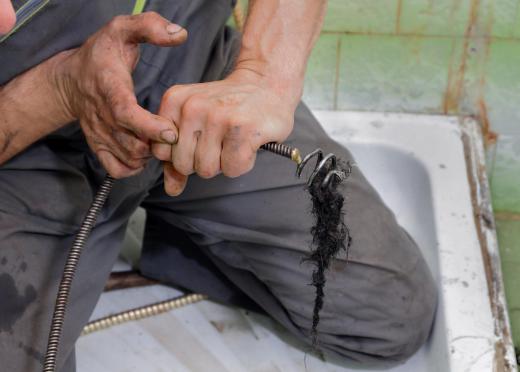A cleanout plug is a cap or lid used to close off a drain cleanout pipe. The term cleanout or cleanout pipe may refer to any branch of a plumbing pipe that is used for cleaning or unclogging the system. These pipes can be found at basement floor drains, in plumbing fixtures, and even at the main sewer pipe leading out of a home or building. The cleanout plug not only helps to keep debris and pests from entering these pipes, but also prevents dangerous sewer gases and noxious fumes from backing up into the home.
Homeowners will commonly encounter a cleanout plug when attempting to repair a clogged basement drain or garage floor drain. Beneath the cover of these drains, there is a standard drainage pipe as well as a metal or plastic cap situated off to one side of the pipe. This cap covers the pipe cleanout, and prevents waste water from entering the cleanout. Instead, the waste water passes directly into the standard sewage pipe.

If this sewage pipe becomes clogged and the drain fails, a plumbing snake may be required to clear the clog. The shape of the drain pipe and integral trap within this pipe makes it very difficult to feed a snake inside and clear a drain. Instead, it's much easier to remove the cleanout plug and insert the snake into the cleanout to clear the clog.
These plugs can be very difficult to remove due to the large variation in their size and configuration. Some cleanout plugs require a standard wrench or screwdriver, while others have recessed heads or raised slots that require special tools. A cleanout plug wrench is designed to accommodate many different kinds of head designs, and may make it easier to remove these plugs. This wrench generally features a six- or eight-sided geometrical shape with different sizes and shapes of tools on each side.
Even with a cleanout plug wrench, these plugs may still be hard to remove due to rusting or corrosion over the years. In this case, plumbers may be forced to break the plug and replace it after the clog has been cleared. By adding Teflon® tape to the threads of the plug, users can make it easier to remove the plug, if necessary, in the future.
A drain with a missing cleanout plug may indicate problems with a home's sewage or drain system. In some cases, this may mean that the drain is clogged and the plug has been removed to allow waste to drain through the cleanout instead. If the drain is fully functional and unclogged, a missing cap may simply be a sign that workers removed the cap at some point and forgot to replace it. In this situation, it is critical to replace the cap as soon as possible to keep dangerous fumes out of the home.
